Histioteuthis miranda: Description continued
Richard E. Young and Michael Vecchione
- Photophores
- Compound photophores of uniform, medium size on most of ventral mantle.

Click on an image to view larger version & data in a new window
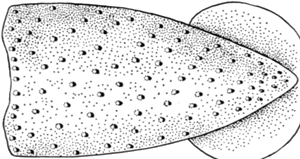
Figure. Ventral view of mantle of H. miranda, 182 mm ML, neotype. Drawing extracted from Fig. 24a of Voss, 1969.
- Compound photophores number usually 16-17 (rarely 15) around right eyelid.

Click on an image to view larger version & data in a new window
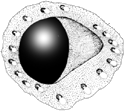
Figure. Lateral view of right eyelid of H. miranda, neotype. Drawing modified from Voss, 1969 (Fig. 25e).
- Arms IV with 5 longitudinal series on arm base (seen in 2 basal rows, then decreases to 4 series).

Click on an image to view larger version & data in a new window

Figure. Ventral view of arm IV of H. miranda, neotype. Drawing from Voss, 1969 (Fig. 24g).
- Tentacles
- Suckers of manus in 6-7 irregular series. Median suckers about twice the size of ventral marginal suckers.

Click on an image to view larger version & data in a new window

Figure. Oral view of club of H. miranda, neotype. Drawing from Voss, 1969 (Fig. 24b).
- Arms
- Subequal; length 100-150% of ML.
- Sucker dentition
- Largest suckers from manus of club with about 45-51 short, irregular, pointed teeth around entire margin (drawing on the left).
- Largest arm suckers with about 5-12 low, blunt or square teeth on distal and lateral margins.

Click on an image to view larger version & data in a new window
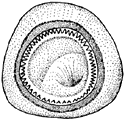
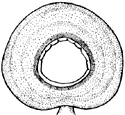
Figure. Oral view of suckers of H. miranda, neotype. Drawing from Voss, 1969 (Fig. 24e, f).
- Tubercles
- Basal 20-40% of each arm I-III with aboral row of tubercles beneath epithelium (arms I with 14-19 tubercles, arms II with 11-16, arms III with 7-13). Also present on anterior half of mantle along dorsal midline. Tubercles difficult to detect in large squid.

Click on an image to view larger version & data in a new window

Figure. Dorsal view of tubercules of H. miranda, 17 mm ML, 32° S, 174° E. Drawing extracted from Fig. 25b of Voss, 1969.
- Web and buccal crown
- Inner web unites basal 16-25% of arms I-III; outer web slightly developed.
- Buccal crown with 7 supports; each connective to arms II divided with one branch attaching to ventral border of arm I.

Click on an image to view larger version & data in a new window
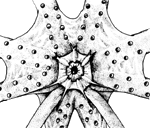
Figure. Oral view of buccal crown of H. miranda, neotype. Drawing from Voss, 1969 (Fig. 25f).
- Fins
- Length 31-44% of ML; width 44-57% of ML.
- Spermatophores
- Length 1.7-2.3% of ML; sperm mass short, 10-14% of spermatophore length (SpL); cement body 62-70% of SpL; ejaculatory apparatus 24-27% of SpL and with single long loop; connective complex well developed with narrow, constricted base.

Click on an image to view larger version & data in a new window
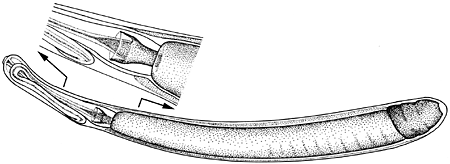
Figure. Spermatophore of H. miranda, 249 mm ML, 34° 43' S, 17° 21' E. Drawing from Voss et al., 1998.
- Hectocotylus
- Mature males with arms I modified on distal third with suckers with palisaded, enlarged pedestals. Basal suckers slightly enlarged with swollen, fleshy collars.
Comments
The above information is taken from Voss (1969) and Voss, et al. (1998).
References
Voss, N.A. 1969. A Monograph of the Cephalopoda of the North Atlantic. The Family Histioteuthidae. Bulletin of Marine Science, 19(4):713-867.
Voss, N.A., K. N. Nesis, P. G. Rodhouse. 1998. The cephalopod family Histioteuthidae (Oegopsida): Systematics, biology, and biogeography. In: Systematics and Biogeography of Cephalopods. (Voss, N.A., Vecchione, M., Toll, R.B. & Sweeney, M.J., eds.). Smiths. Contr. Zool., 586(2): 293-372.
About This Page
Drawings from N. Voss, printed with the Permission of the Bulletin of Marine Science.
Richard E. Young

University of Hawaii, Honolulu, HI, USA
Michael Vecchione

National Museum of Natural History, Washington, D. C. , USA
Page copyright © 2000
Richard E. Young
and
Michael Vecchione
 Page: Tree of Life
Histioteuthis miranda: Description continued
Authored by
Richard E. Young and Michael Vecchione.
The TEXT of this page is licensed under the
Creative Commons Attribution-NonCommercial License - Version 3.0. Note that images and other media
featured on this page are each governed by their own license, and they may or may not be available
for reuse. Click on an image or a media link to access the media data window, which provides the
relevant licensing information. For the general terms and conditions of ToL material reuse and
redistribution, please see the Tree of Life Copyright
Policies.
Page: Tree of Life
Histioteuthis miranda: Description continued
Authored by
Richard E. Young and Michael Vecchione.
The TEXT of this page is licensed under the
Creative Commons Attribution-NonCommercial License - Version 3.0. Note that images and other media
featured on this page are each governed by their own license, and they may or may not be available
for reuse. Click on an image or a media link to access the media data window, which provides the
relevant licensing information. For the general terms and conditions of ToL material reuse and
redistribution, please see the Tree of Life Copyright
Policies.


This page is a note that is attached to a
leaf of the Tree of Life.
ToL notes provide brief accounts of characteristics, short summaries,
commentaries, media files, taxonomic information, or identification tools
for a given group of organisms.
For a more detailed explanation of the different ToL page types, have a look at the
Structure of the Tree of Life page.
close box
Page Content
articles & notes
collections
people
options
Explore Other Groups
other Histioteuthidae
containing groups














 Go to quick links
Go to quick search
Go to navigation for this section of the ToL site
Go to detailed links for the ToL site
Go to quick links
Go to quick search
Go to navigation for this section of the ToL site
Go to detailed links for the ToL site